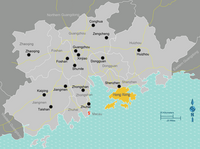
Photo from wikipedia
Industrial carbon emissions are the main part of China's carbon emissions, so industrial carbon emission reduction is an important tool to achieve the "double carbon" target. This paper constructs a… Click to show full abstract
Industrial carbon emissions are the main part of China's carbon emissions, so industrial carbon emission reduction is an important tool to achieve the "double carbon" target. This paper constructs a Tapio model to decompose the total decoupling indicators into energy saving decoupling indicators and emission reduction decoupling indicators, with a view to revealing more deeply the reasons and mechanisms for the changes in the decoupling indicators between economic growth and carbon dioxide emissions in the industrial sector of each prefecture-level city in Guangdong Province, as well as using cluster analysis to further explore the changes in the effect of energy saving and emission reduction in the industrial sector over the three five-year plans. The conclusions showed that: (1) the overall efficiency of energy saving and emission reduction in the industrial sector of Guangdong Province has improved, but there are large differences in efficiency between different cities; (2) the energy structure of the industrial sector in Guangdong Province has changed little due to immature technology. Based on the above findings, this paper puts forward corresponding policy recommendations.
Journal Title: International Journal of Low-Carbon Technologies
Year Published: 2023
Link to full text (if available)
Share on Social Media: Sign Up to like & get
recommendations!